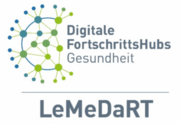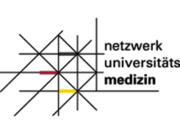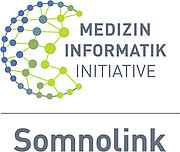You are here
Content
Application-oriented development environment for effective cross-sectoral digital healthcare (AHEAD)
Building on the results of the automated digital patient admission in TEDIAS , the corresponding infrastructure and development environment, the network established in this way and the concepts developed, this project (AHEAD) aims to establish a digital bridge along the patient pathway across sector boundaries, which enables a structured data flow and thus automatic data preparation and processing in a real application scenario. Similar to TEDIAS, this is a modular framework that allows for test and development operations and thus provides support in clinical practice as well as serving as an anchor point for commercial development projects, among others. The applicants are already working intensively on the topic and a correspondingly intensive exchange has been established in the consortium, which means that the project can be started promptly.
Further Information:

Centre of Excellence in Digital Health and Personalized Medicine, Luxembourg - Grand Est - Baden-Württemberg (CLINNOVA)
The "Clinnova" project brings together clinicians and researchers from Luxembourg, France, Germany, and Switzerland in an international cooperation. The core idea of this initiative is to make optimum use of the potential of precision medicine for treatment decisions. This goal is to be achieved by linking data, standardization, and ensuring interoperability. The overall aim is to create a common starting point for the development of medical AI algorithms in the European center. The implementation of the project is supported by FNR, Grand Est, the Canton of Basel-Stadt, and the State of Baden-Württemberg.
Further information:
- www.uniklinik-freiburg.de/presse/pressemitteilungen/detailansicht/2611-10-millionen-euro-foerderung-fuer-grenzueberschreitende-digitale-gesundheitsinitiative.html
- www.lih.lu/en/article/clinnova-to-launch-precision-medicine-initiative-across-europe/

Digital Progress Hub Health: Lean Medical Data - the right data at the right time (LeMeDaRT)
The LeMeDaRT project aims to create interoperable systems that integrate knowledge from healthcare and research. The focus is on the interaction between data integration centers in university clinics, medical practices, and regional hospitals. LeMeDaRT shows how digitalization can improve healthcare in remote rural areas, including medical treatment, health promotion, prevention, aftercare, and rehabilitation. The long-term goal is an efficient, digitally networked healthcare system that helps doctors, therapists, and patients to identify illnesses at an early stage and find the best possible individual therapy.
Further information:
- www.umm.uni-heidelberg.de/cpd/projekte/lemedart/
- www.gesundheitsforschung-bmbf.de/de/lemedart-digitaler-fortschrittshub-gesundheit-lean-medical-data-die-richtigen-daten-zur-14260.php

MIDorAI junior research group (Head: Dr. Máté Maros, MSc)
The MIDorAI research group works on the topics of extracting structured data from unstructured healthcare data (findings, image data), data quality and suitability of healthcare data for machine learning purposes as well as interoperable provision of disease models based on the "FAIR Guiding Principles" (Findable, Accessible, Interoperable, Reusable).
Further information:

Network University Medicine: Third funding phase (NUM-DIC)
The established MII DICs have built up their IT infrastructures, services, processes, regulations, and committees in accordance with MII-wide agreements through earlier funding. As part of NUM funding, the DICs participated in projects such as NUM-CODEX, NUM-RDP, and NUM-CODEX+ to use data from COVID-19 patients for pandemic research.
In the current work, the aim is to learn from previous project experiences and to act as a service provider for both pandemic preparedness and pandemic-independent medical research. The NUM project structures are to develop into MII structures.
Further information:
- www.netzwerk-universitaetsmedizin.de/en/projects/all-num-projects
- www.netzwerk-universitaetsmedizin.de/en/media/news/detail/clinical-research-bmbf-funding-ensures-seamless-continuation-of-the-network-of-university-medicine

Somnolink: Improving diagnosis, treatment, and adherence to therapy for obstructive sleep apnoea
Pauses in breathing, known as apnoeas, usually occur during sleep due to a narrowing of the upper airways in the throat. Even if those affected are often unaware of this, the - unconscious - wake-up reactions that restart breathing make sleep less restful. If such apneas occur more than five times an hour, this is known as obstructive sleep apnea (OSA). Typical consequences are daytime tiredness and poor concentration, as well as an increased risk of cardiovascular disease. With around 26 million people affected, Germany is one of the top 10 countries with the most OSA patients. In view of this health challenge, efficient and targeted treatment of OSA is necessary. In Somnolink, sleep physicians and medical informatics specialists want to work together with those affected to improve the diagnosis, treatment, and adherence to treatment for OSA through better availability of health data and AI-based analyses.
Further information:

Center for Innovative Care (ZIV)
As part of this project, a consortium of medical faculties and university hospitals will be established to found a "Center for Innovative Care" (ZIV). The aim is to optimize patient care in Baden-Württemberg through digital medicine. This includes involving patients in the process of prevention, treatment and aftercare, for example through an app. In this way, instead of a snapshot during a clinic visit, a more comprehensive picture of the state of health and its progression can be created for each patient.
Further information:

